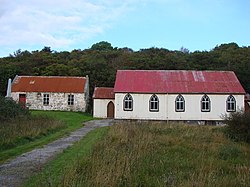
Sutherland is a historic county, registration county and lieutenancy area in the Highlands of Scotland. The name dates from the Viking era when the area was ruled by the Jarl of Orkney; although Sutherland includes some of the northernmost land on the island of Great Britain, it was called Suðrland from the standpoint of Orkney and Caithness.

Caithness is a historic county, registration county and lieutenancy area of Scotland.

Durness is a village and civil parish in the north-west Highlands of Scotland. It lies on the north coast of the country in the traditional county of Sutherland, around 120 miles north of Inverness. The area is remote, and the parish is huge and sparsely populated, covering an area from east of Loch Eriboll to Cape Wrath, the most north-westerly point of the Scottish mainland.

Kinlochbervie is a scattered harbour village in the north west of Sutherland, in the Highland region of Scotland. It is the most northerly port on the west coast of Scotland.

Lairg is a village and parish in Sutherland, Scotland. It has a population of 891 and is at the south-eastern end of Loch Shin.

Forss Water, known also as Forss River, has its source at the northern end of Loch Shurrey, at grid reference ND042568. About 13 kilometres north of its source the river flows into Crosskirk Bay and the Atlantic Ocean at ND029700. Crosskirk Bay is on the north coast of Great Britain and about 8 kilometres west of the burgh of Thurso, Caithness, in Highland, Scotland. The river marked the eastern extent of the Clan Mackay raid in the Sandside Chase of 1437.

Bettyhill is a village in the parish of Farr, on the north coast of Scotland.

Golspie is a village and parish in Sutherland, Highland, Scotland, which lies on the North Sea coast in the shadow of Ben Bhraggie. It has a population of around 1,350.

Achtoty is a remote hamlet in the Scottish Highland Council area. Achtoty is about 26 miles (42 km) west of Thurso.

Strathnaver or Strath Naver is the fertile strath of the River Naver, a famous salmon river that flows from Loch Naver to the north coast of Scotland. The term has a broader use as the name of an ancient province also known as the Mackay Country, once controlled by the Clan Mackay and extending over most of northwest Sutherland.

Borgie is a hamlet in Sutherland, Highland, Scotland. Historically it was part of the 12,600-acre (5,100-hectare) Tongue estate with shooting rights, and it contains the Borgie Lodge, now a bed and breakfast. Borgie is noted for its salmon, which are caught in the nearby River Borgie.

Farr is a parish in the county of Sutherland in the Scottish council area of Highland. The parish also includes a small hamlet named Farr. The village of Bettyhill lies less than 1 mile to the west of the hamlet along the A836 road.
Armadale is a small village on the north coast of Scotland, in the council area of Highland. The village is part of the parish of Farr, in the county of Sutherland. Armadale is about 30 miles west of the town of Thurso, off the A836 road. The population of Armadale is 50 and shrinking, with 32% of the population being retired, and the remaining 68% population are working or at school.
Badcall comprises two remote hamlets, called Lower Badcall and Upper Badcall. Upper Badcall, a crofting township, is the larger of the two and is situated on the western shore of Badcall Bay. Lower Badcall is located less than 1 mile to the east on the eastern shore of Badcall Bay. Badcall is on the west coast of Sutherland, Scottish Highlands and is in the Scottish council area of Highland.

Torrisdale is a remote hamlet on the western shore of Torrisdale Bay in Sutherland, Highland, on the north coast of Scotland. It is 3 kilometres (2 mi) west of Bettyhill.

Skerray Bay is an arm of the Atlantic Ocean, located on the north coast of Sutherland, Highland, Scotland. Small and rocky, it is situated to the north of Clashbuie and northwest of the crofting community of Skerray. The rock, Càrn Mòr, it at the entrance, while the channel, Caol Beag, separates Coomb Island from the mainland. Strathan Skerray - Skerray Bay is a Geological Conservation Review site. Walkers enjoy the 8 miles (13 km) Skerray Bay to Tongue trek.

The Kyle of Tongue is a shallow sea loch in northwest Highland, Scotland, in the western part of Sutherland. Featuring a rocky coastline, its mouth is formed at Tongue Bay. The community of Tongue is situated on the Kyle's eastern shore and the loch is crossed by the Kyle of Tongue Bridge and Causeway.

The Kyle of Tongue Bridge is part of the Kyle of Tongue Causeway, which crosses Kyle of Tongue sea loch on the north coast of Scotland.
Strathnaver Museum is located in Bettyhill, Sutherland, Scotland. It is a fully accredited volunteer-run independent museum which first opened in 1976. It explores the history of north west Sutherland through the context of the Highland Clearances. The Clan Mackay Centre is located on the 1st floor of the main museum building.




















